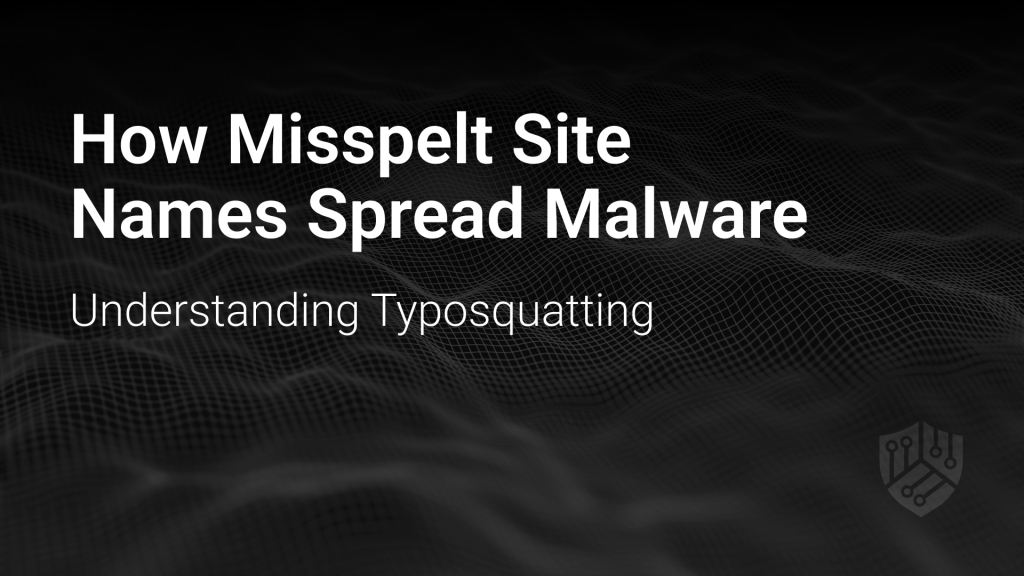June 20, 2025
How Misspelt Site Names Spread Malware: Understanding Typosquatting

You make a small typo when you type in the URL of a popular site. This is all cybercriminals need to infect your device with malware. Known as typosquatting, this practice is increasingly concerning as it affects both individual users and businesses. In this article, the CyberFlow cybersecurity team explains how typosquatting works and its potential dangers.
What is Typosquatting?
Typosquatting is a new way of scamming internet users. Hackers identify common spelling mistakes of popular websites and register these domain names. Thus, when a visitor accidentally mistypes a web address, instead of getting the message “404 – Page Not Found”, they land on a malicious site.
For example, if you wanted to visit “amazon.com” but accidentally typed “amazom.com” or “amaz0n.com,” you might end up on a fake website that looks real. However, if you interact with it, it will steal your information or infect your device with malware.
The Growing Threat of Domain Typosquatting
But that’s not all. Domain typosquatting is not just about website impersonation anymore. Hackers now target developers and business owners with misspelt names of popular software, as well.
For example, they created fake versions of popular programming libraries like “Colorama” by registering variations such as “col0rama” or “coloramaa.” When a developer accidentally downloads and installs the fake library, they infect their device with malware, allowing hackers to gain control and steal their data.
How Fake Websites That Look Real Are Built
Cybercriminals have taken the art of imitating genuine websites to unbelievable levels. These malicious sites are exact copycats of the design, layout, and functionality of legitimate websites. The only difference might be a single character in the domain name that most users won’t notice at first glance.
Hackers leave nothing to chance when creating malicious duplicates of popular websites:
- Imitating visuals: Copying logos, colour schemes, and page layouts from trusted brands
- Using CTAs: Using urgent messages or attractive offers to encourage quick action
- SSL certificates: Even malicious sites can obtain security certificates, making them appear legitimate
- Functional elements: Including working search bars, login forms, and other interactive features.
To the average user, it looks just like the website they wanted to reach. But, as soon as they type in the login details, hackers take control of their account or prompt them to install malware disguised as a helpful tool.
Typosquatting in Cybersecurity: A Multi-Platform Threat
This type of attack is particularly difficult to contain because it exploits human error rather than technical vulnerabilities. Thus, traditional security measures alone are ineffective.
Modern typosquatting campaigns have become increasingly sophisticated, targeting multiple operating systems simultaneously. Attackers now create different versions of malware for Windows and Linux systems, using advanced techniques to avoid detection by antivirus software.
Once installed, these malicious programs can:
- Create hidden processes that run continuously in the background
- Disable security software and firewalls
- Steal login credentials and sensitive business data
- Establish persistent access to compromised systems
- Communicate with criminal networks through encrypted channels
The Business Impact of Typosquatting Attacks
The consequences of typosquatting attacks go beyond immediate system infection. When employees accidentally visit malicious sites or install fake software packages, your entire business IT network is infected with malware.
The financial impact includes costs related to:
- Incident response
- System recovery
- Compliance violation penalties
- Potential lawsuits from affected customers.
You will also lose your business reputation and your customers’ trust. And these are the hardest to regain after a successful cyberattack.
Small and medium-sized businesses are the most vulnerable because they often lack dedicated cybersecurity teams to identify and respond to these threats quickly.
Let CyberFlow Protect Your Business from Typosquatting!
Don’t let a simple typo take down your business IT network. CyberFlow’s advanced cybersecurity solutions create a multi-layered protection against typosquatting, malware, and other advanced threats.
We monitor your network 24/7, conduct vulnerability assessments and help you create a solid cybersecurity awareness program for your employees!
Contact us today and let us keep your IT systems and devices safe from hackers!
About Us
If you are interested on apply more security to your business contact us
